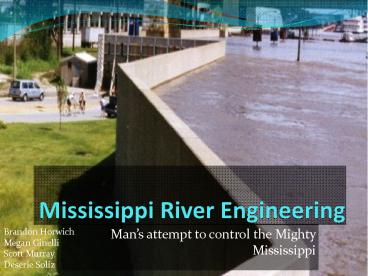Mississippi River Engineering - PowerPoint PPT Presentation
Title:
Mississippi River Engineering
Description:
Mississippi River Engineering. Man s attempt to control the Mighty Mississippi. Brandon Horwich. Megan Ginelli. Scott Murray. DeserieSoliz – PowerPoint PPT presentation
Number of Views:155
Avg rating:3.0/5.0
Title: Mississippi River Engineering
1
Mississippi River Engineering
- Mans attempt to control the Mighty Mississippi
Brandon Horwich Megan Ginelli Scott
Murray Deserie Soliz
2
Quantifying the flood effects of river
engineering on the Mississippi River system
- Have human activities caused, or worsened, large
floods worldwide in recent years?
3
- Models were used to quantify changes in flood
levels at specific stations along the Mississippi
and Missouri Rivers in response to construction
of - wing dikes
- bendway weirs
- meander cutoffs
- navigational dams
- bridges
- other modifications.
4
Maximum annual stages respond to all climate- and
land-use-driven changes in flow plus instream
conveyance changes. The good correlation in
Figure (b) and the poor correlation in Figure (a)
suggests that the instream changes had a greater
effect upon net flood magnitudes over time on
this river system.
5
Wing Dikes
- Wing dikes constructed downstream of a location
were associated with increases in stage,
consistent with backwater effects upstream of
these structures. - Stages increased 10.8 /- 0.6 cm for each 1000
meters of wing dike built within 20 river miles
downstream.
6
Levees
Each 1 increase in leveed area downstream was
associated with a 2.2 /- 0.2 cm increase in
stages.
However, on other river reaches, the levees
resulted in local decreases as well as increases
in stage.
7
Case study conclusions
- Discharge records from 66 stations on the
Mississippi River system confirm a pattern of
increasing flows. - Significant trends only detected on the upper
Mississippi River - Total change in flood levels correlate strongly
with instream river modifications (e.g. dikes and
levees).
8
Floodplain Geomorphic Processes
- Human alteration along coastal plain rivers
9
Effects of Roanoke river dam
10
(No Transcript)
11
Causes of increases erosion
- Decreased sediment loads that enhance entrainment
of banks and beds - Decrease amount of sediment delivered and stored
on or near banks - Consistent wetting of lower bank due to diurnal
flow fluctuation, due to energy generation. (this
also promotes greater erodability - Channel degradation which allows for flow
impingement low on the banks, removes stabilizing
materials
12
Effects of channelization, channel incision and
valley aggradations in West Tennessee
13
Valley plug
14
Atchafalaya Basin
15
(No Transcript)
16
(No Transcript)
17
(No Transcript)
18
Case Study The 1993 Flood
Report of the Interagency Floodplain Management
Review Committee To the Administration Floodplain
Management Task Force
19
The Big One
- 100 year flood
- Surpassed all previous floods in US history
- Record precipitation, flood stages, flood
duration, area of flooding, economic losses - 500 yr floodLargest flood since 1543
- Flood observed during the DeSoto expedition
20
Factors
- Extensive rains
- Storm systems moving south, at roughly the same
speed as flow - Early flood storms in north basin
- Late flood storms south in basin
- Heavy summer rains, saturated soils
- Estimated SWHC
- 10in across floodplain
- Summer rains
- exceeded 15in
- Irrigated croplands
21
Influences of Levees
- Upper Mississippi River
- Levees limited destruction in large urban areas
i.e. St. Louis - Estimated levees raised flood stage 2.4ft
- Still 17ft above flood stage
- Assuming floodplain SWHC was not saturated
- Middle Mississippi River
- 11ft lower if levees absent
22
Flood Reservoirs
23
Wetlands Losses from 1780-1980
24
SAST Conclusions
- Levees or Reservoir Dams did not cause the 1993
flood. During large events such as occurred in
1993. levees have minor overall effects on
floodstage, but may have significant localized
effects - There are locations where levees should not be
built. In many cases set-back levees might allow
normal river functions while providing flood
control. - Loss of wetlands significantly decreases
floodplain water holing capacity, which results
in higher flood stages downstream
25
Conclusions
26
Flood-control levees influence on the flood regime
- When the levees are removed, the area that could
be flooded increases. - Flood heights were increased on order of
centimeters due to levees. - When looking at 100-yr flood, both shear stress
and unit stream power was nonexistent outside of
levees due to lack of flow. - Power inside the levees was lower than in
completely unleveed areas.
27
Management implication for large-floodplain rivers
- Some suggestions for levees is to have a system
of setback levees that can maintain natural
floodplain vegetation composition while also
allowing some flood control. - Take advantage of the natural geomorphic
processes within the area which will help
rejuvenate the area. - A catchment-based approach could be used to
preserve the dynamics of a geomorphologically
active system
28
References
- Executive Office of the President Interagency
Floodplain Management Review Committee. 1994.
Sharing the Challenge Floodplain Management into
the 21st Century. lt http//eros.usgs.gov/sast/2P-0
0526.PDFgt - Freeman, Gary E., S.K. Nanda, Maurice J.
Mausback, Ronald E. Erickson, John A. Kelmelis,
Byron D. Stone, William H. Kirby, James R. Reel.
1994. The Scientific Assessment and Strategy Team
Contributions Assessing the 1993 Flood on the
Mississippi and Missouri River Basins. Water
International. Vol 19 pp. 177-185. - Gergel, Sarah E., Mark Dixon, Monica G. Turner.
2002. Consequences of Human-Altered Floods
Levees, Floods, and Floodplain Forests along the
Wisconsin River. Ecological Applications. vol
126 1755-1770. - Hupp. Cliff R., Aaron R. Pierce, Gregory B. Noe.
2009. Floodplain Geomorphic Processes and
Environmental Impacts of Human Alteration along
Coastal Plain Rivers, USA. Wetlands. Vol 29 no 2
pp. 413-429. - Pinter, Nicholas, Abebe A. Jemberie, Jonathan W.
F. Remo, Reuben A. Heine, Brian S. Ickes. 2008.
Flood Trends and River Engineering on the
Mississippi River System. Geophysical Research
Letters. Vol 35. L23404.































